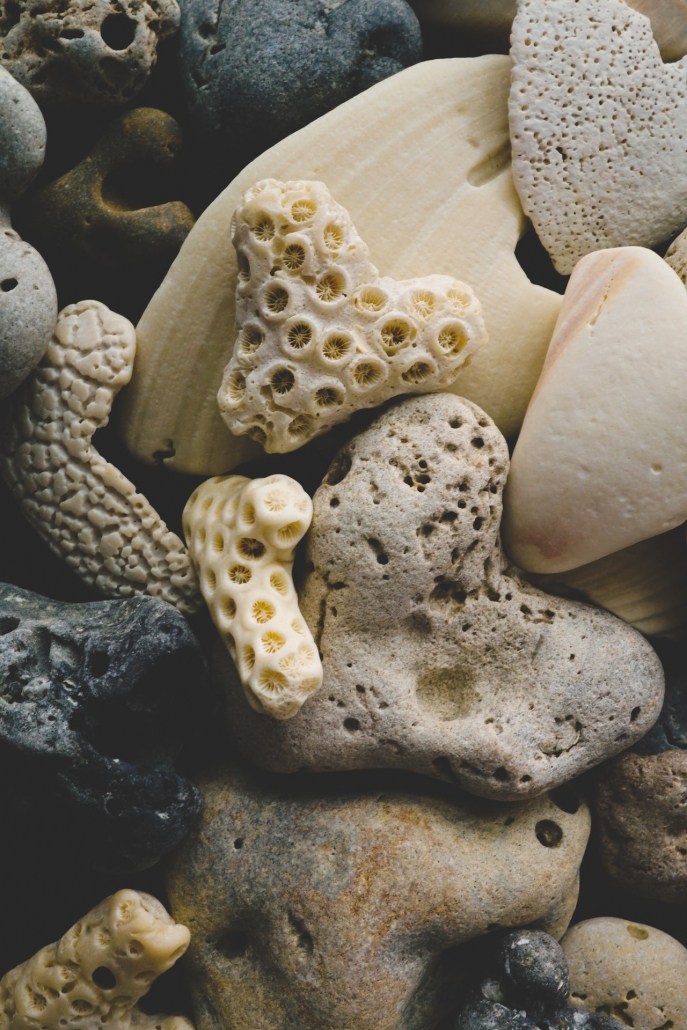Shells, Corals, and other Carbonate Samples: Analysing U-Th, C-14, Strontium, Boron, and Oxygen Isotopes
Shells, corals and other carbonates are widely used in order to assess variability in climate and environmental conditions in time. A variety of stable and radioactive isotopes can be used to date these samples and provide further information on environmental context during their lifespan.
U-Th dating has been used extensively to date shell, coral and carbonate samples, offering the potential to date shells up to 500,000 years before present (cal BP) – far beyond the timespan available using the 14C dating method (ca. 40,000 cal BP). This method relies on the sample having incorporated uranium during formation, and concurrently having limited thorium input from external sources. The most ideal samples exist within a closed system (e.g. corals), leaving all thorium within the structure being a product of U-Th decay (see Assumptions of U-Th dating).
Shells and foraminifera are technically open systems, which makes U-Th dating challenging. Whilst corals are generally thought to be a closed system, they have been shown in some cases to gain and lose 234U, 230Th and 234Th, generating a bias towards older ages (Andersen et al. 2009). However, systematic corrections can be applied using a screening approach making corals more suitable for dating than other carbonate types (e.g. Thompson et al., 2003).
Radiocarbon (14C) analysis is another option to date shell, coral and carbonate samples based on fitting the 14C level of the sample on the radiocarbon calibration curve. This method allows dating from the present day until approximately 40,000 years before present. However, shells, corals and other marine-based carbonates are subject to the “reservoir effect” and recrystallisation – both of which can impact the accuracy of 14C dating. As a result, careful site-based calibration and subsampling is required. Furthermore, in archaeological studies, the “old shell” effect should be considered if old shells may have been used for beads or decor (Rick et al. 2005). (Read more about radiocarbon dating shells and carbonates).
Strontium isotopes (87Sr, 86Sr) in seawater have varied through time in the geological past. Shells, corals, marine carbonates and other organic matter present in the ocean takes up strontium isotopes, resulting in a snapshot of oceanic strontium during their lifetime. By measuring the 87Sr/86Sr ratio in the sample and placing it on the standard seawater Sr-curve the age of the sample can be determined. However, issues with homogeneity of seawater strontium make sample calibration difficult (Meknassi et al. 2018).
Beyond Sr-curve aging, recent studies have shown that Sr uptake of certain shells is a function of local seawater temperature (Toland et al. 2000), thus Sr may also be used as a paleothermometer in combination with calcium (Ca) analysis. (Read more about Strontium Isotopes).
Boron isotopes (δ11B) are a function of seawater pH and thus can be measured in shells, corals and carbonates to decipher changes in pH and ocean acidification through time which reflects past atmospheric CO2 concentrations. Shells, corals and other marine carbonates are particularly vulnerable to ocean acidification and thus numerous studies are currently underway to assess how pH level has varied through time and what implications this has for the vitality of these organisms (Rae et al. 2011; Rae 2018). (Read more about Boron Isotopes).
Oxygen isotopes (δ18O) vary in response to temperature, humidity, precipitation and other climate parameters. Similar to boron and strontium, marine organisms take up oxygen in their growth structures, providing insight into oxygen variability – and thus climate variability – through time. Oxygen isotopes in corals and shells can be used to reconstruct sea surface temperature and in some cases, precipitation (Rollion-Bard et al. 2011; Leng & Lewis, 2016). (Read more about Oxygen Isotopes).
The reconstruction of environmental changes through time using corals, shells and marine carbonates requires a robust chronology using methods such as U-Th or 14C dating. Once dated, these samples can be further analyzed to provide many paleoenvironmental reconstructions, including: wet/dry phases (Yehudai et al. 2017), mortality/recovery of coral reef systems (Clark et al. 2017), seawater temperature (DeCarlo et al. 2016) and pH (Stewart et al. 2016; Pauly et al. 2015). For further information about how you can integrate multi-proxy analysis of your shell, coral or carbonate samples, contact us!
References
Andersen, M.B., Gallup, C.D., Scholz, D., Stirling, C.H. and Thompson, W.G., (2009). U-series dating of fossil coral reefs: consensus and controversy. Pages News, 17, pp.54-56.
Clark, T.R., Roff, G., Zhao, J.X., Feng, Y.X., Done, T.J., McCook, L.J. and Pandolfi, J.M., (2017). U-Th dating reveals regional-scale decline of branching Acropora corals on the Great Barrier Reef over the past century. Proceedings of the National Academy of Sciences, 114(39), pp.10350-10355. DOI: 10.1073/pnas.1705351114
DeCarlo, T.M., et al. (2016) Coral Sr‐U thermometry. Paleoceanography 31.6 (2016): 626-638. DOI: 10.1002/2015PA002908
Leng, M.J. and Lewis, J.P., (2016). Oxygen isotopes in Molluscan shell: applications in environmental archaeology. Environmental Archaeology, 21(3), pp.295-306. DOI: 10.1179/1749631414Y.0000000048
Meknassi, E.L., Dera, S., Cardone, G., De Rafélis, T., Brahmi, M., and Chavagnac, V., (2018). Sr isotope ratios of modern carbonate shells: Good and bad news for chemostratigraphy. Geology, 46(11), pp.1003-1006.
Pauly, M, et al. (2015) Coralline algal Mg-O bond strength as a marine p CO2 proxy. Geology 43.3: 267-270. DOI: 10.1130/G36386.1
Rae, J.W., Foster, G.L., Schmidt, D.N. and Elliott, T., (2011). Boron isotopes and B/Ca in benthic foraminifera: Proxies for the deep ocean carbonate system. Earth and Planetary Science Letters, 302(3-4), pp.403-413. DOI: 10.1016/j.epsl.2010.12.034
Rae, J.W., (2018). Boron isotopes in Foraminifera: Systematics, biomineralisation, and CO 2 reconstruction. Boron Isotopes, pp.107-143.
Rick, T.C., Vellanoweth, R.L. and Erlandson, J.M., (2005). Radiocarbon dating and the “old shell” problem: direct dating of artifacts and cultural chronologies in coastal and other aquatic regions. Journal of Archaeological science, 32(11), pp.1641-1648. DOI: 10.1016/j.jas.2005.05.005
Rollion-Bard, C., Chaussidon, M. and France-Lanord, C., (2011). Biological control of internal pH in scleractinian corals: Implications on paleo-pH and paleo-temperature reconstructions. Comptes Rendus Geoscience, 343(6), pp.397-405. DOI: 10.1016/j.crte.2011.05.003
Stewart, A., Anagnostou, E. and Foster, G.L., (2016). An improved boron isotope pH proxy calibration for the deep-sea coral Desmophyllum dianthus through sub-sampling of fibrous aragonite. Chemical Geology 447: 148-160. DOI: 10.1016/j.chemgeo.2016.10.029
Toland, H., W. T. Perkins, N. J. G. Pearce, F. Keenan, and M. J. Leng, (2000). A study of sclerochronology by laser ablation ICP-MS, J. Anal. At. Spectrom., 15, 1143–1148. DOI: 10.1039/B002014L
Thompson, W.G., et al. (2003). An open-system model for U-series age determinations of fossil corals. Earth and Planetary Science Letters 210.1-2: 365-381. DOI: 10.1016/S0012-821X(03)00121-3
Yehudai, M. et al. (2017). U–Th dating of calcite corals from the Gulf of Aqaba. Geochimica et Cosmochimica Acta 198: 285-298. DOI: 10.1016/j.gca.2016.11.005
Coral image: https://www.pexels.com/photo/gray-and-beige-heart-shaped-corral-collection-804094/

